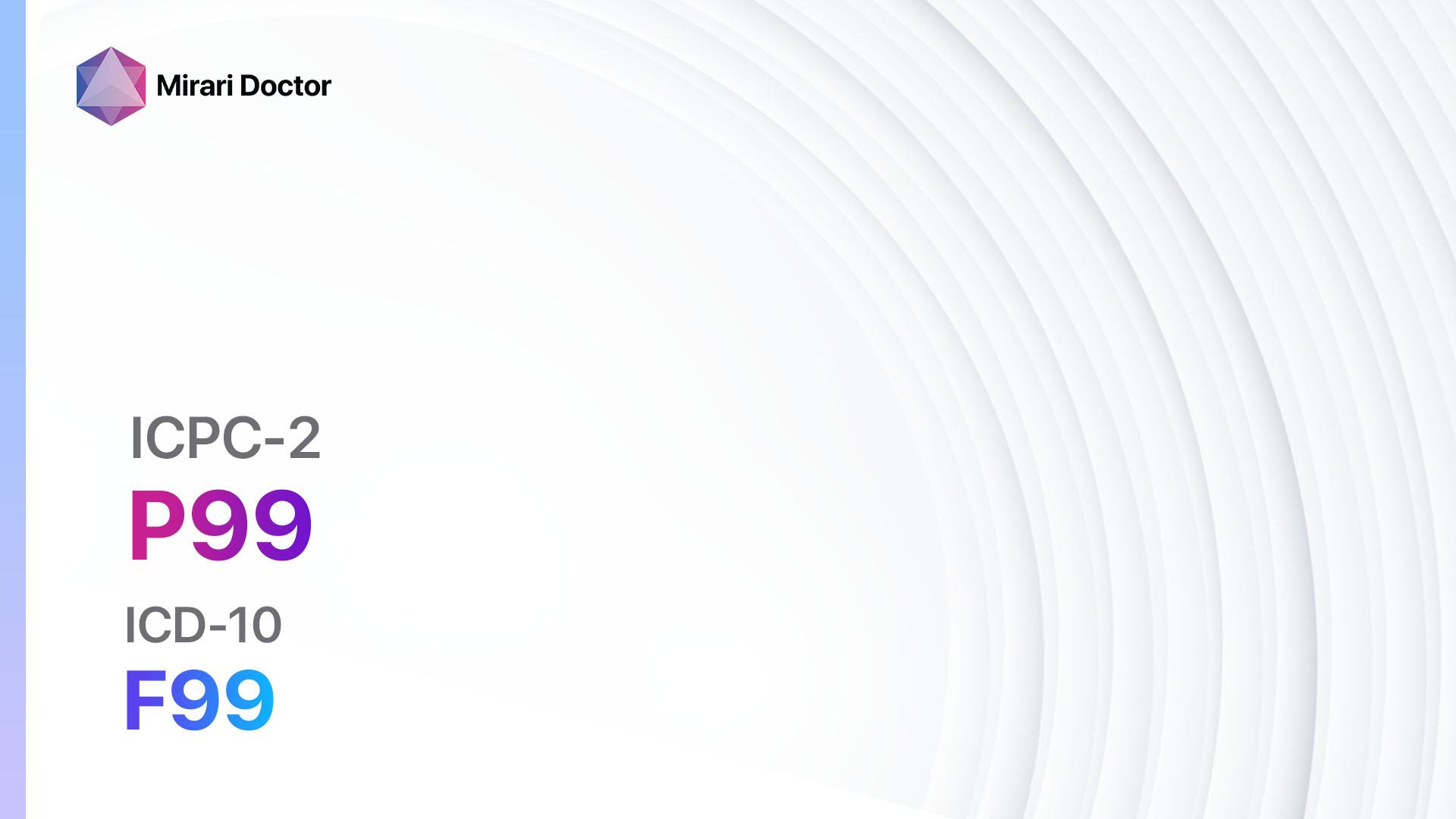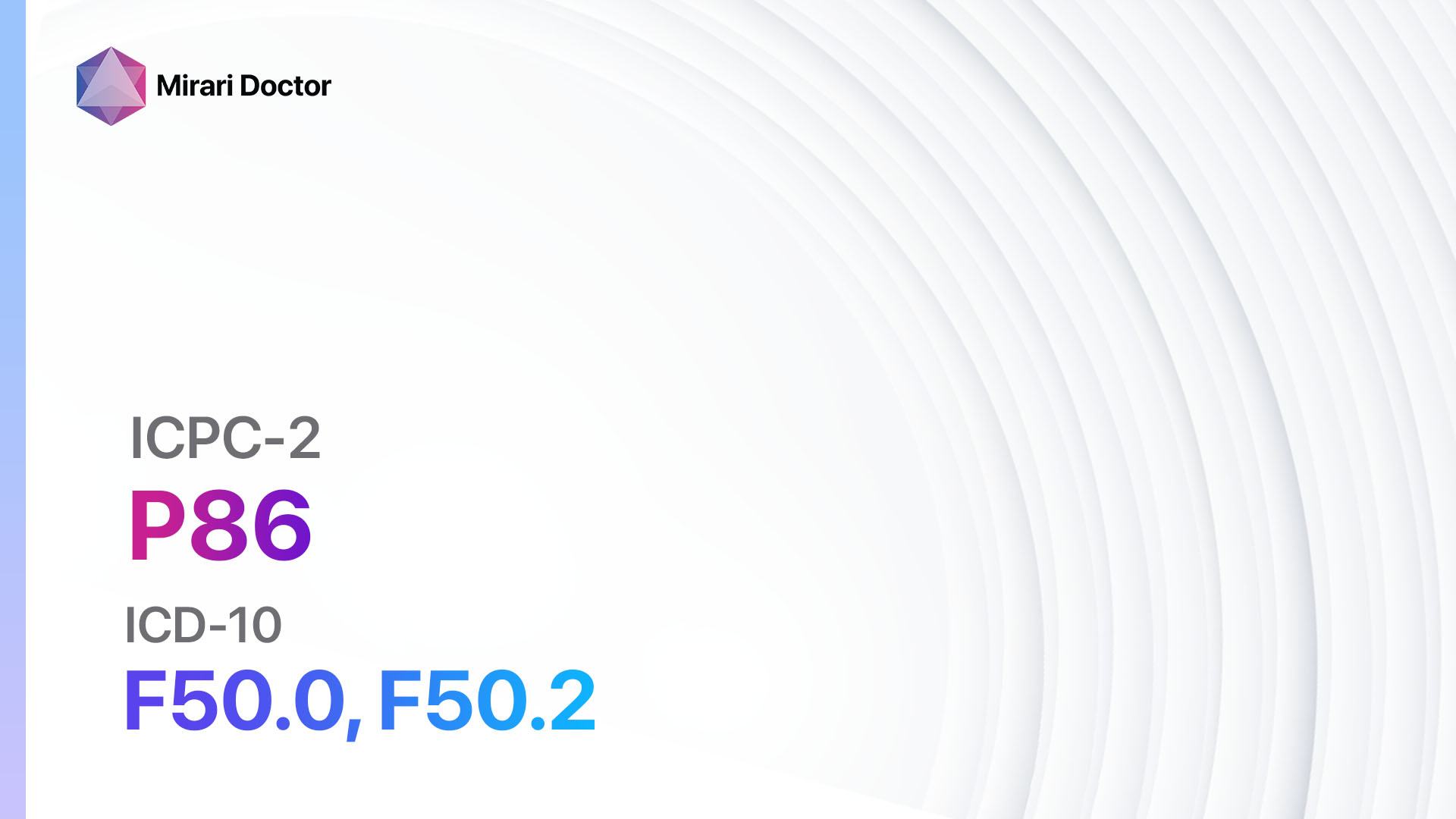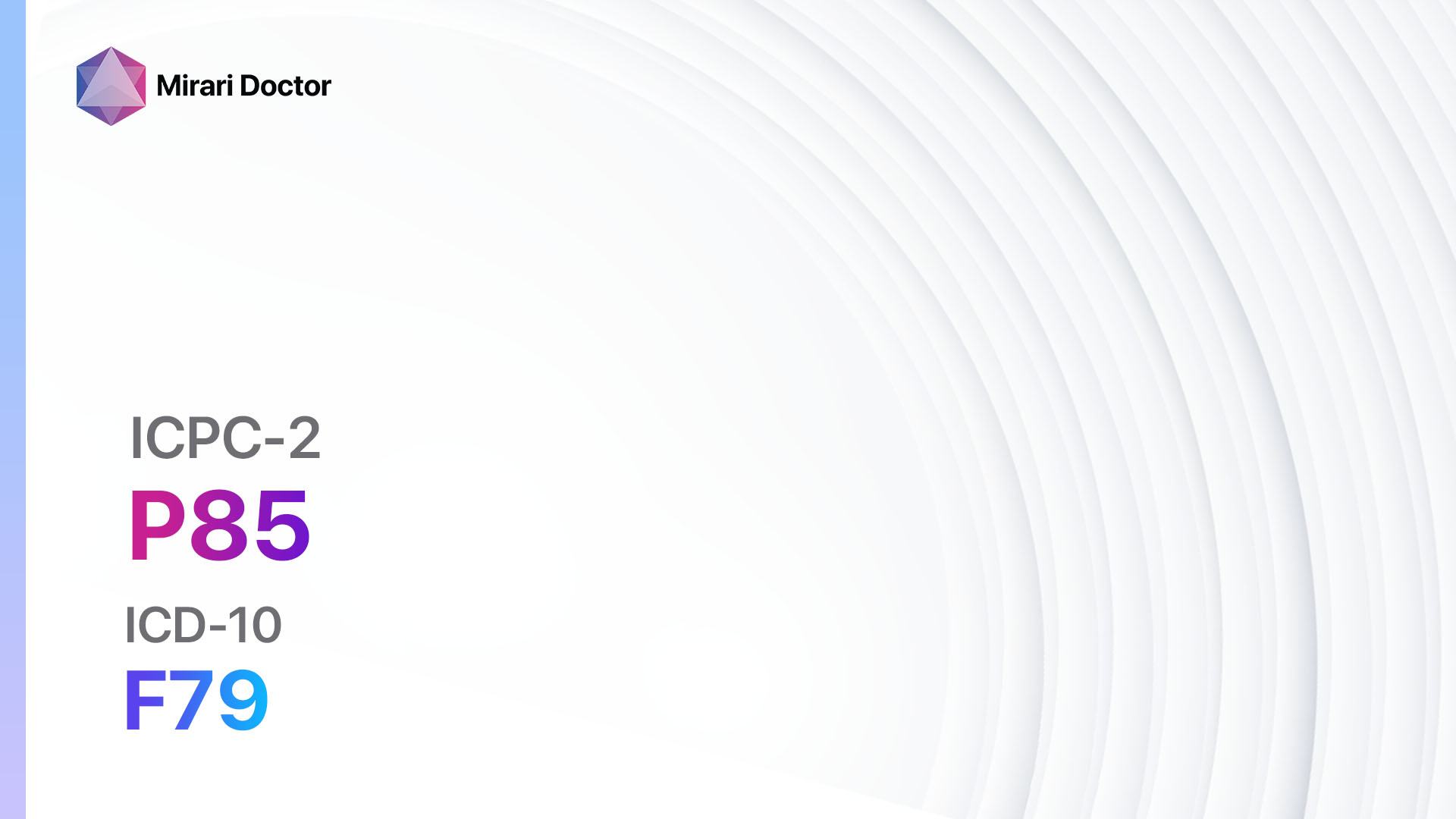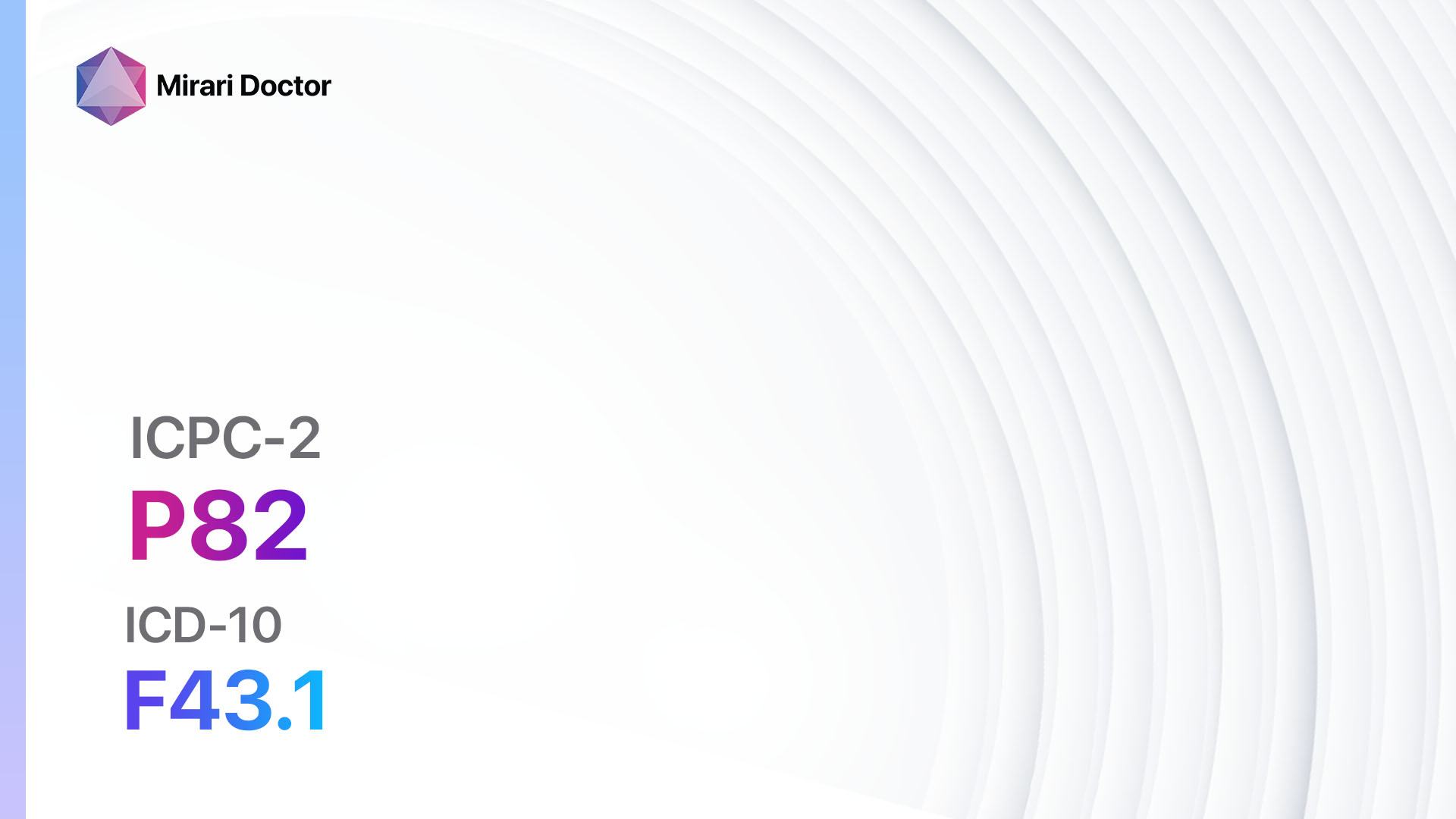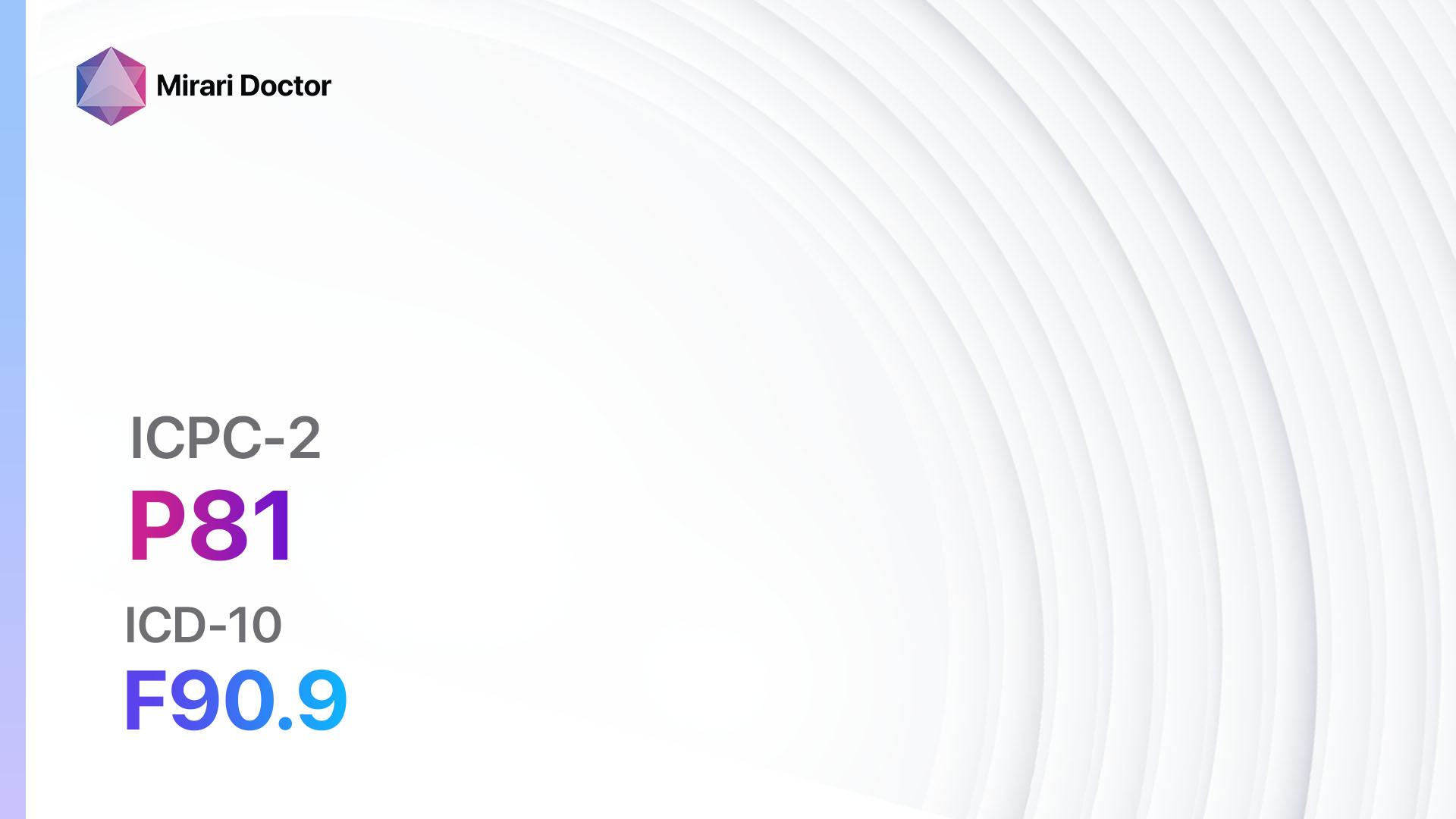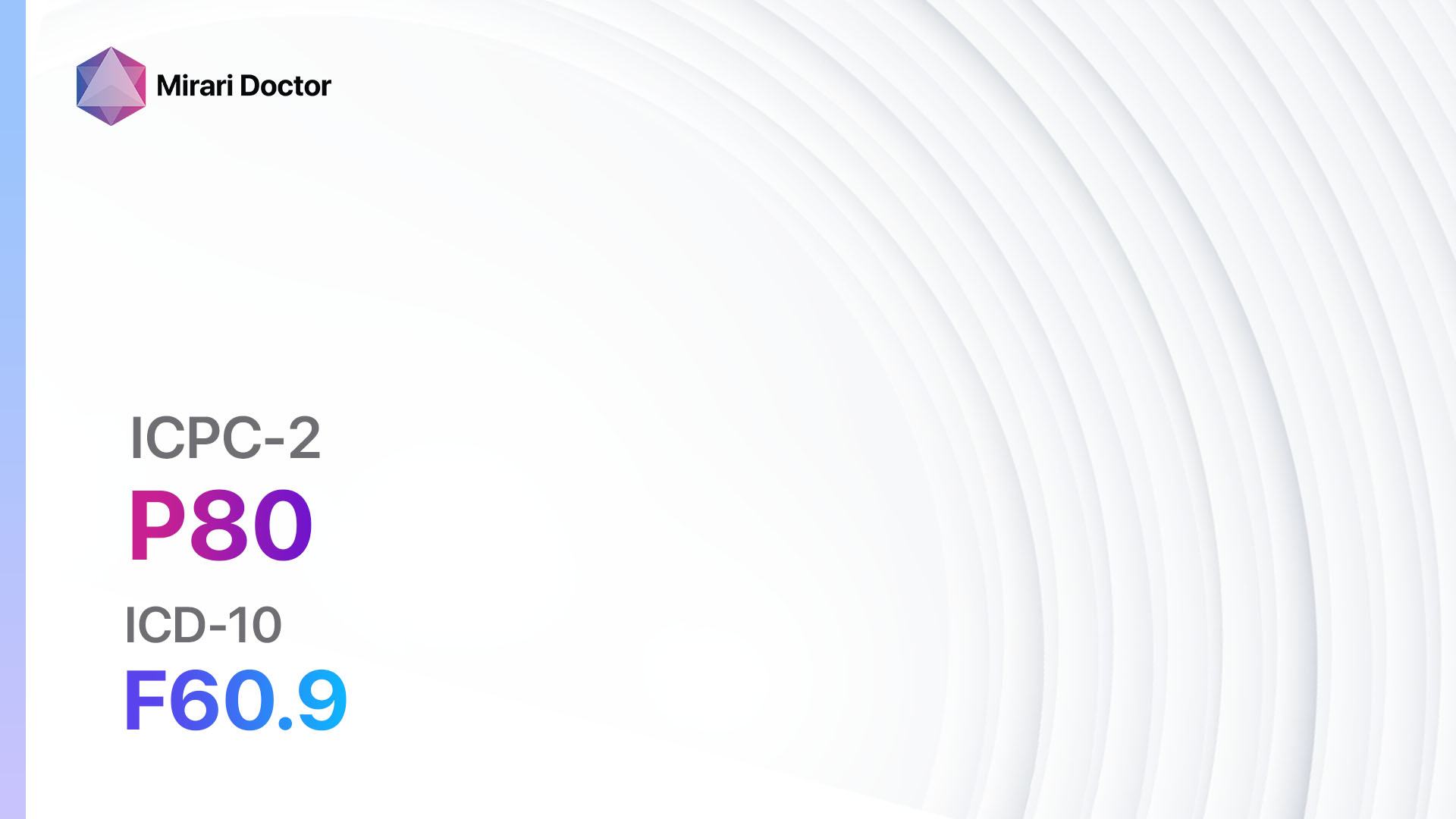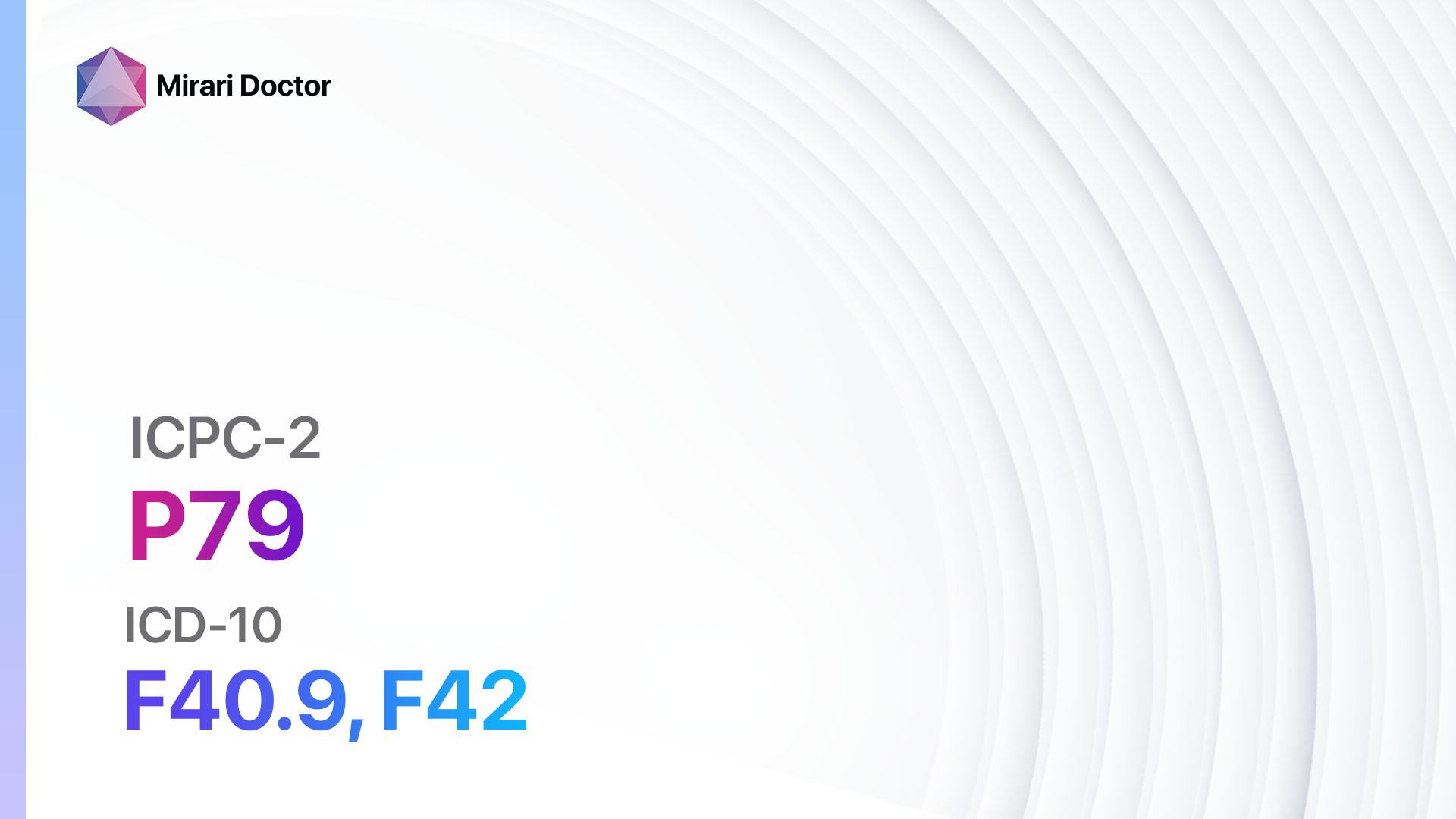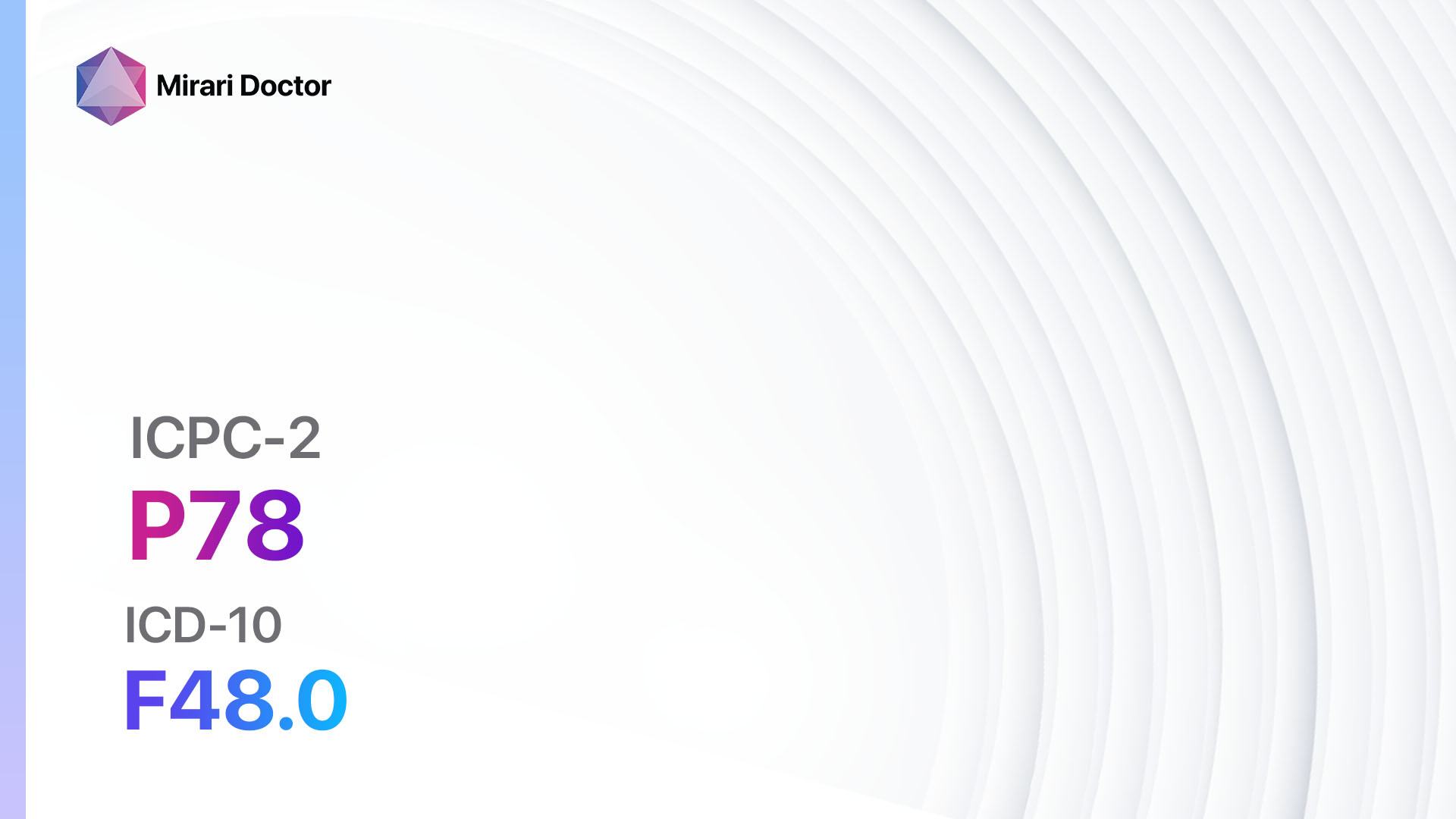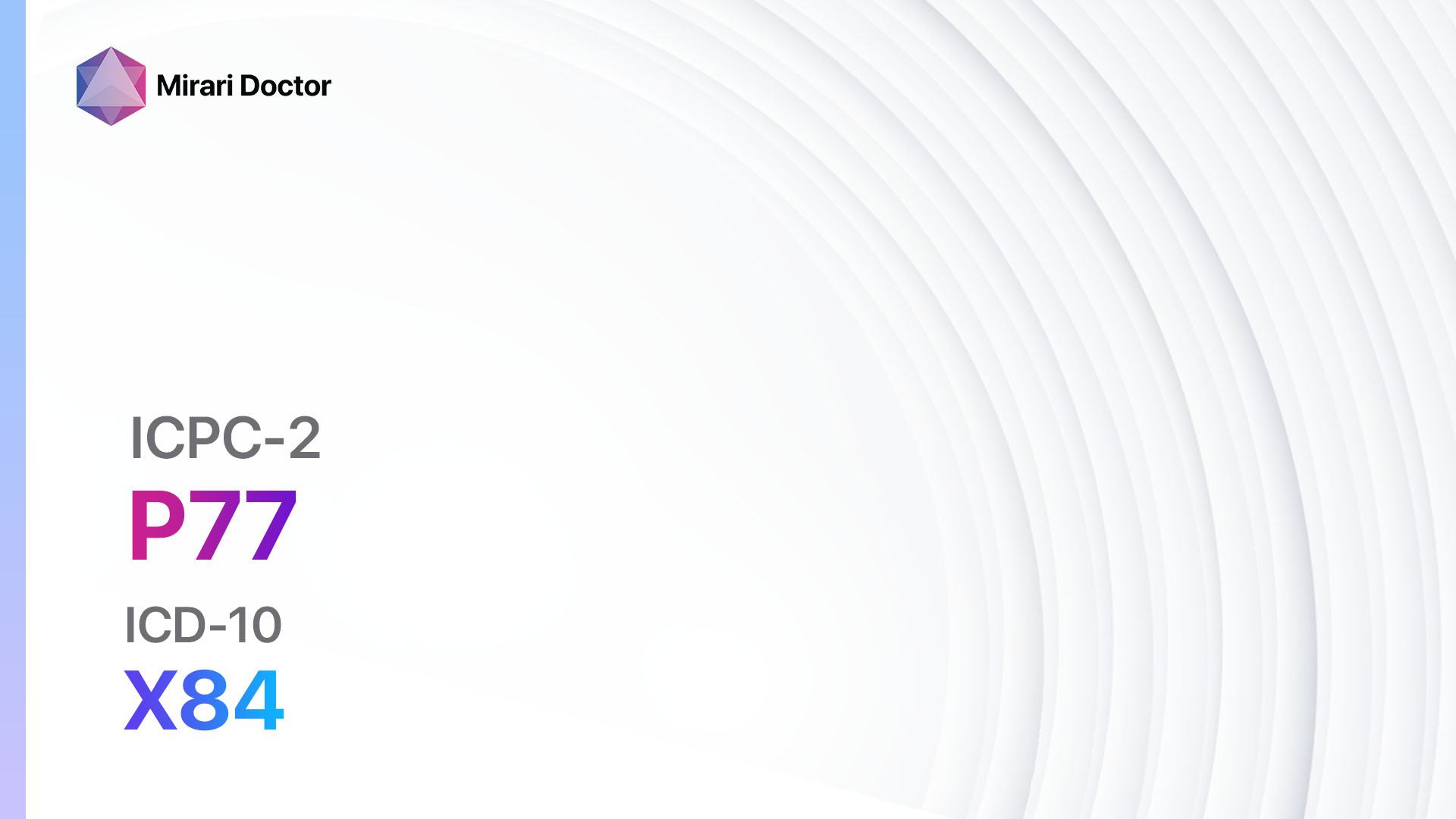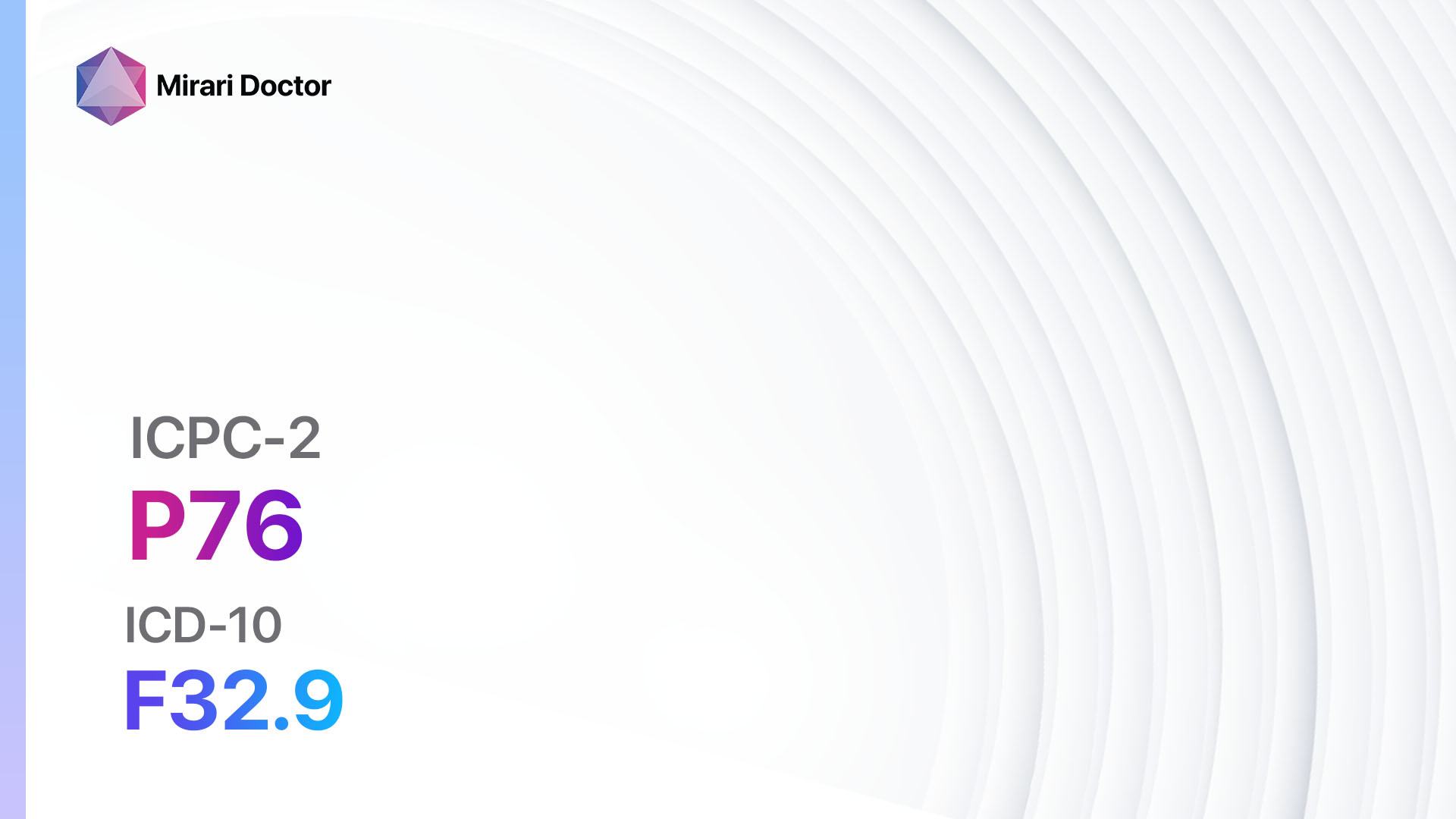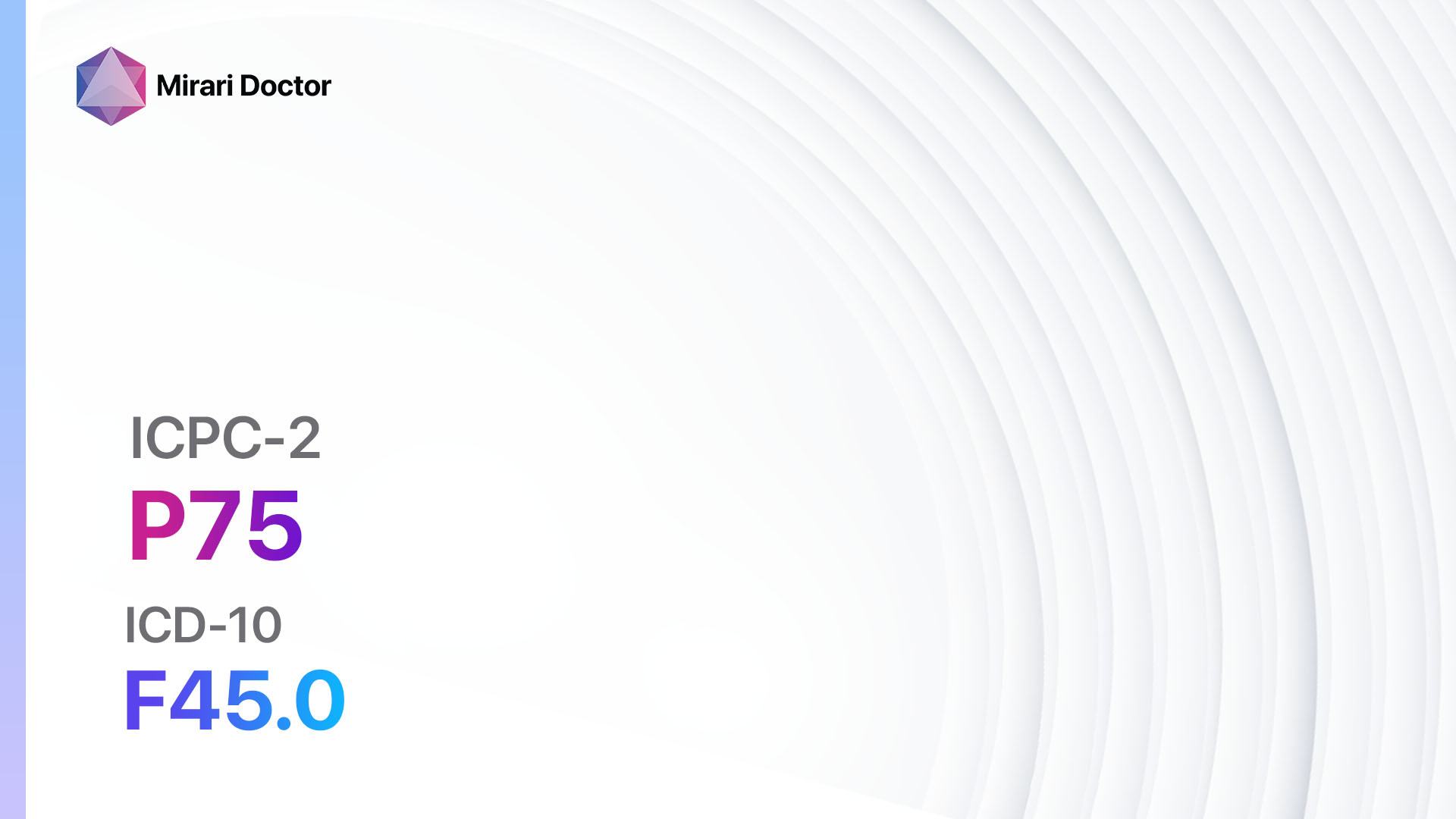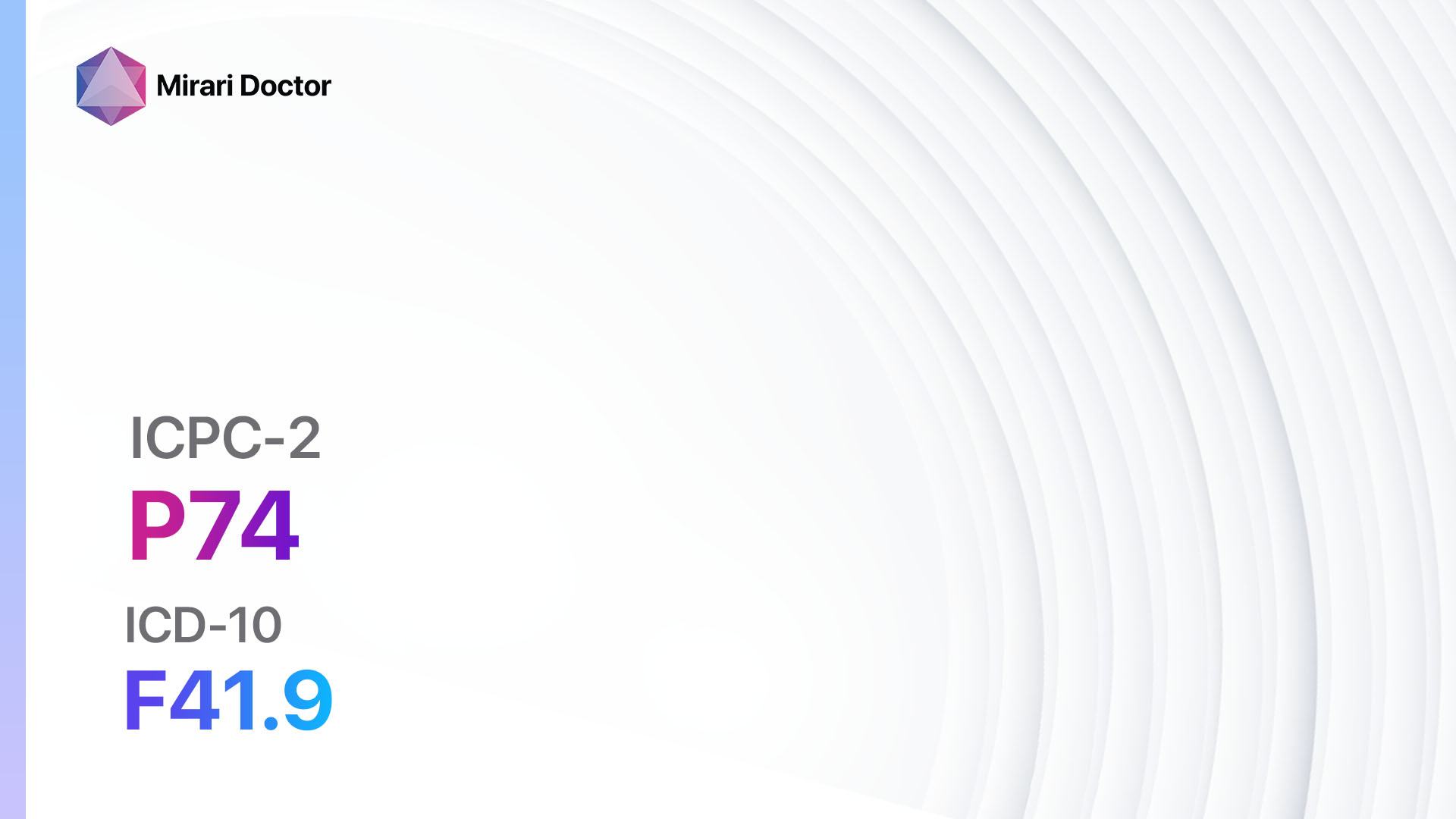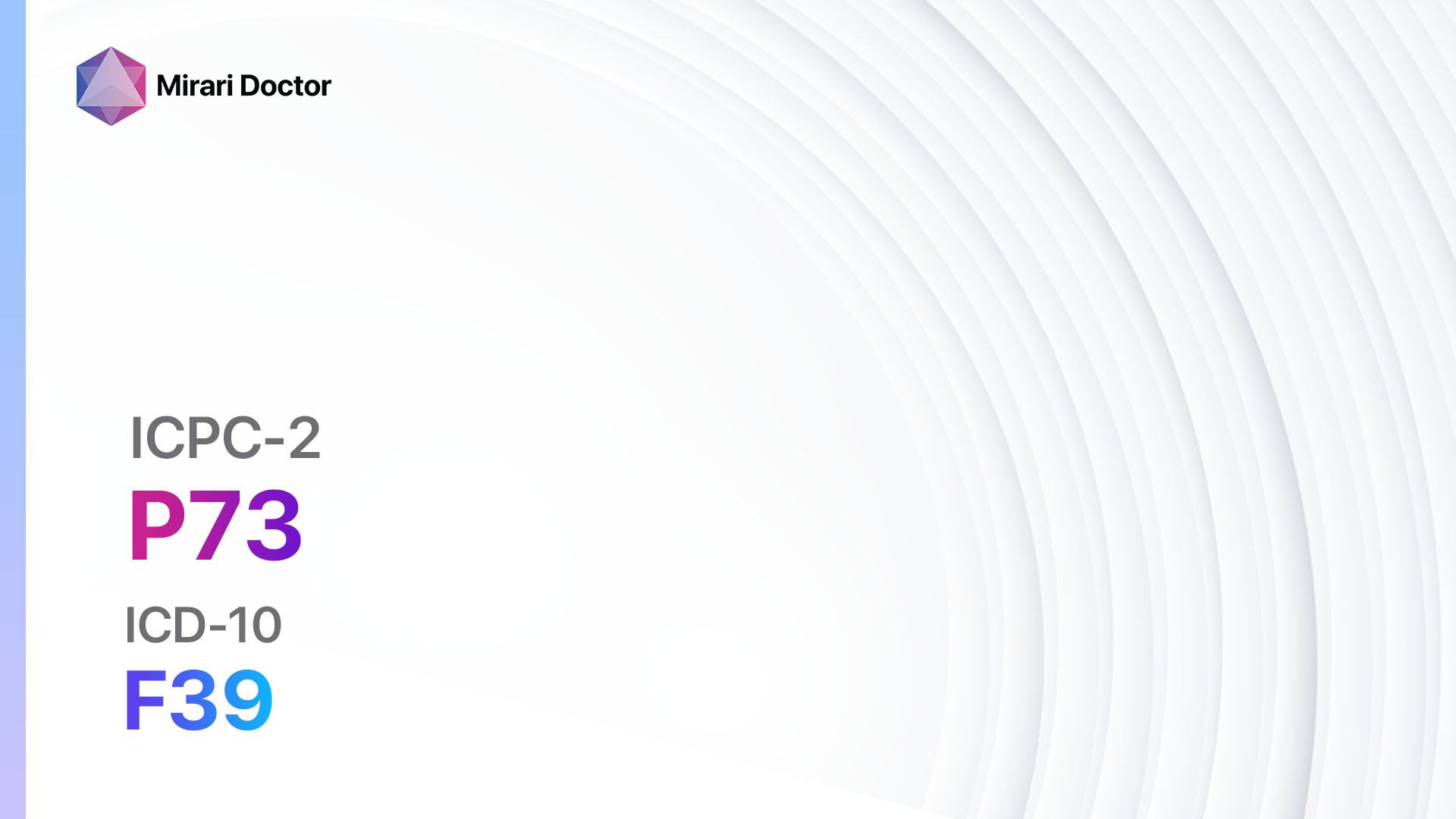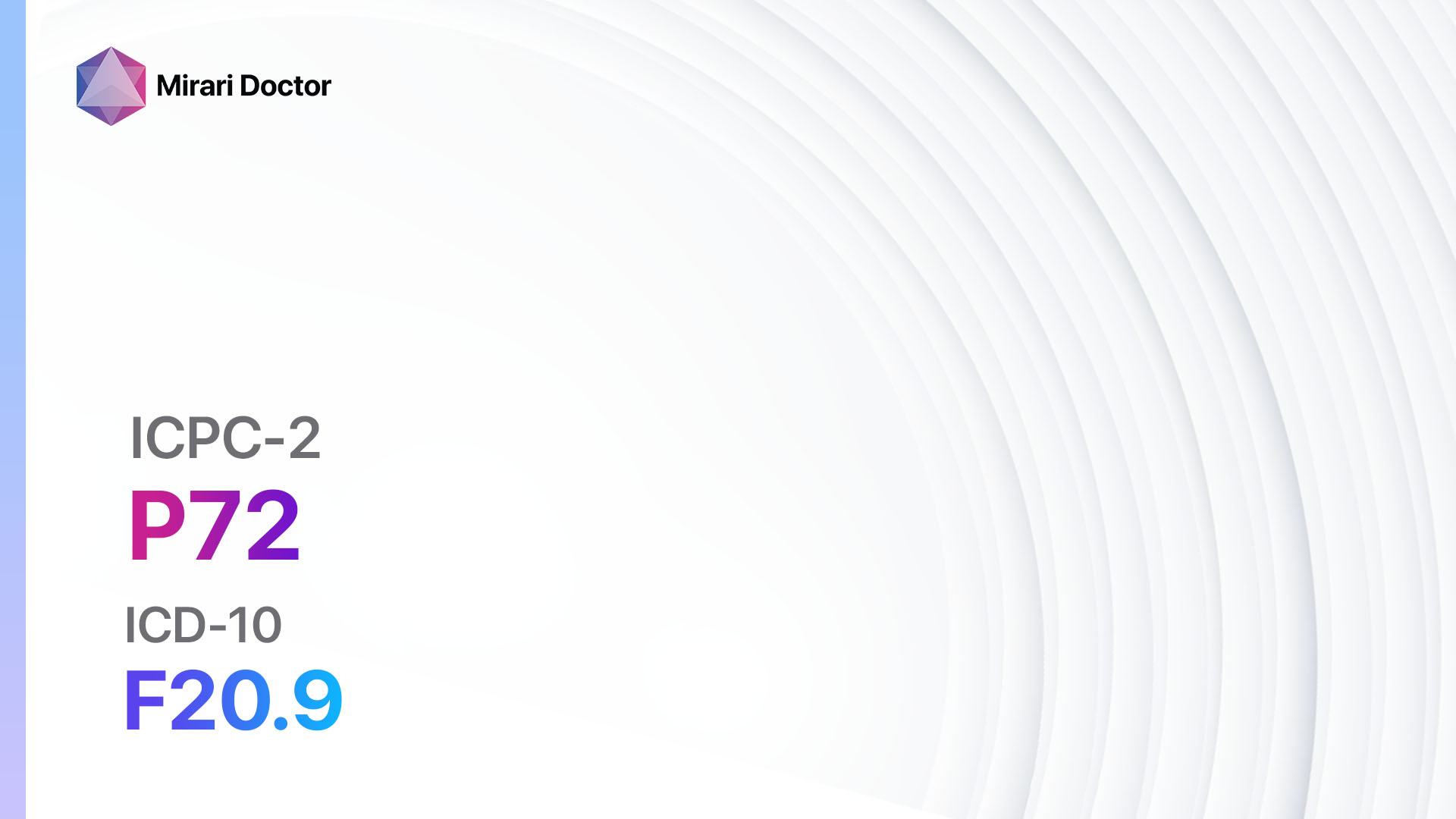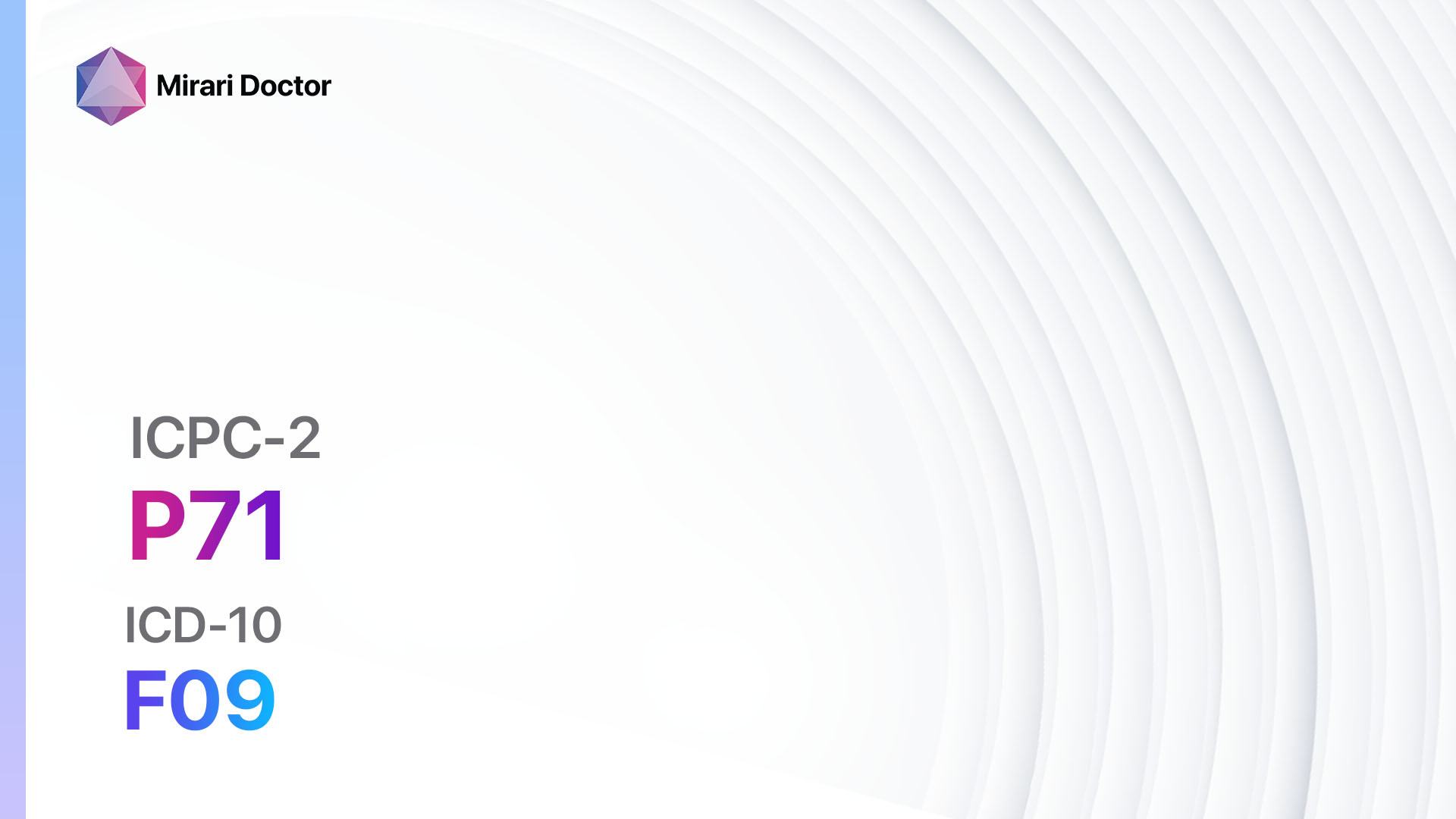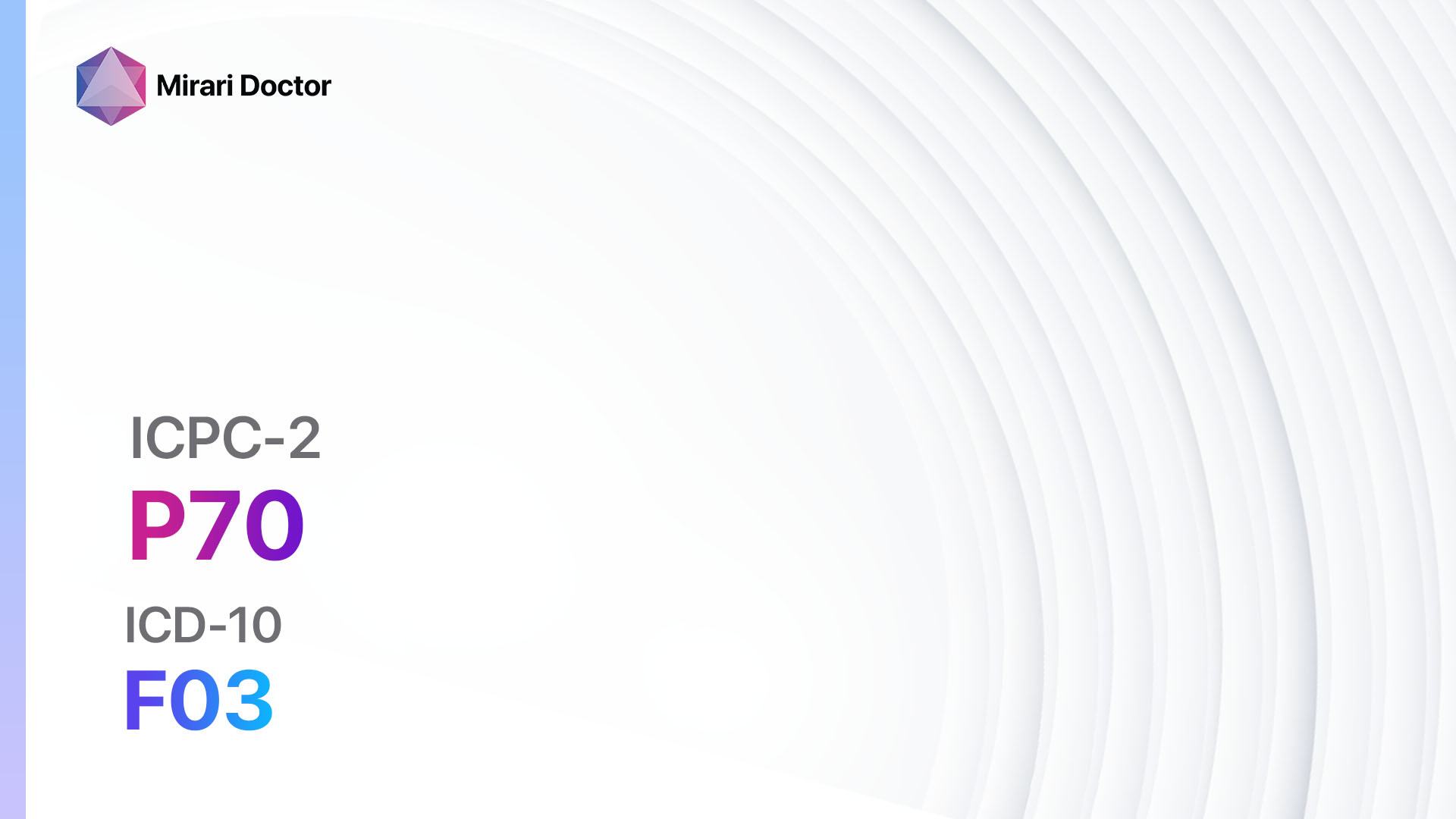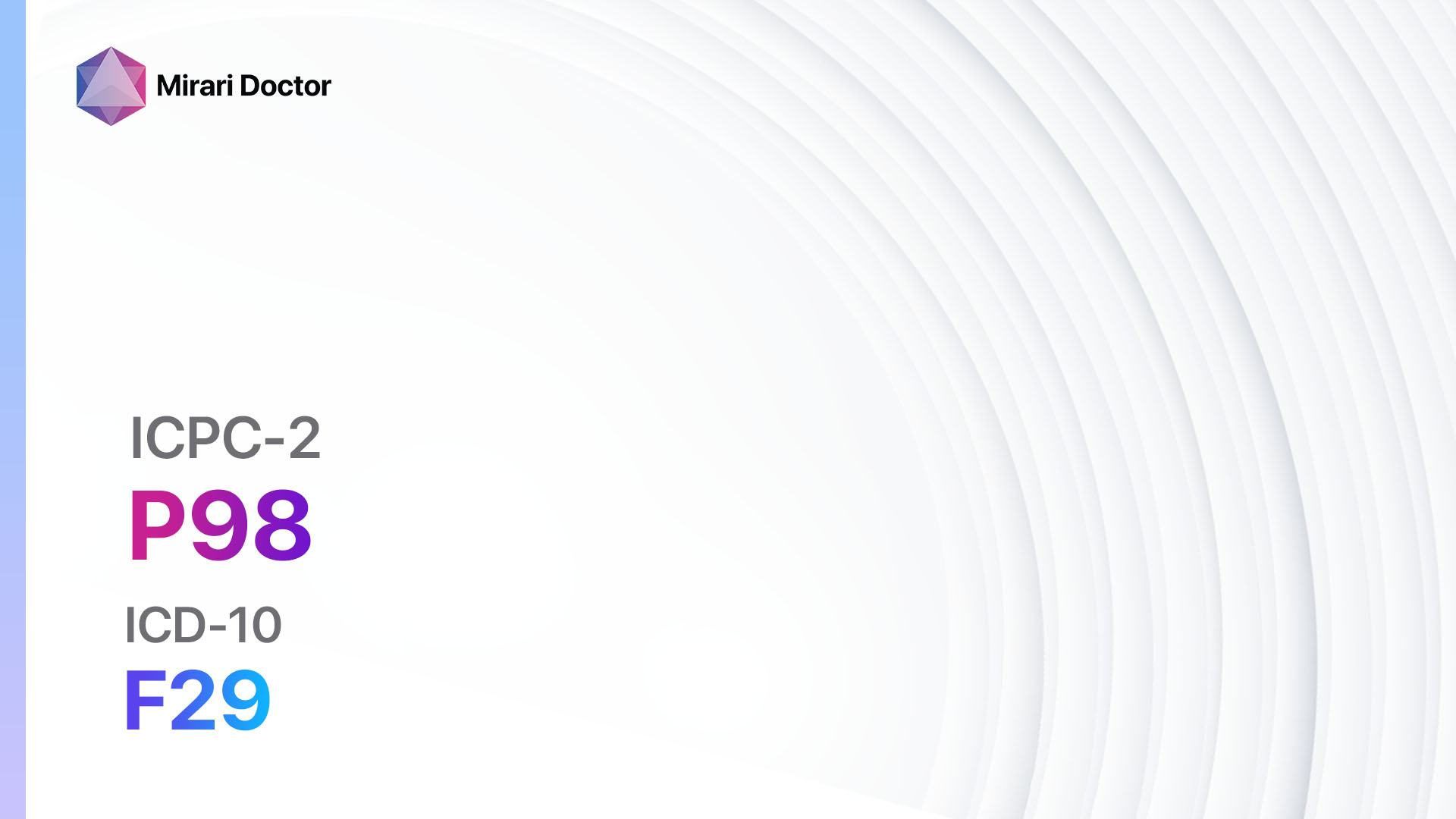
Introduction
Psychosis NOS (Not Otherwise Specified) refers to a condition where individuals experience symptoms of psychosis that do not meet the criteria for a specific psychotic disorder[1]. It is a significant condition as it can greatly impact an individual’s daily functioning and quality of life[2]. The aim of this guide is to provide an overview of the symptoms, causes, diagnostic steps, possible interventions, and lifestyle interventions for Psychosis NOS/other.
Codes
- ICPC-2 Code: P98 Psychosis NOS/other
- ICD-10 Code: F29 Unspecified nonorganic psychosis
Symptoms
- Delusions: False beliefs that are not based on reality[3].
- Hallucinations: Sensations or perceptions that are not real, such as hearing voices or seeing things that are not there[4].
- Disorganized thinking: Incoherent or illogical thoughts and speech[5].
- Disorganized behavior: Unusual or unpredictable behavior, such as dressing inappropriately or acting in a socially inappropriate manner[6].
- Negative symptoms: Reduced ability to initiate and sustain goal-directed behavior, such as reduced motivation, social withdrawal, and decreased emotional expression[7].
Causes
- Genetic factors: Family history of psychosis or other mental health disorders[8].
- Environmental factors: Exposure to trauma, stress, substance abuse, or certain infections during pregnancy or early childhood[9].
- Neurochemical imbalances: Imbalances in neurotransmitters, such as dopamine, serotonin, or glutamate, in the brain[10].
- Structural brain abnormalities: Changes in brain structure or function, such as enlarged ventricles or decreased gray matter volume.
Diagnostic Steps
Medical History
- Gather information about the patient’s personal and family medical history, including any history of mental health disorders.
- Identify any risk factors, such as substance abuse, trauma, or exposure to infections.
- Assess the patient’s symptoms and their impact on daily functioning.
Physical Examination
- Perform a thorough physical examination to rule out any underlying medical conditions that may be causing or contributing to the symptoms of psychosis.
- Pay attention to any signs or findings that may indicate neurological or endocrine abnormalities.
Laboratory Tests
- Blood tests: To rule out any underlying medical conditions, such as infections, metabolic disorders, or hormonal imbalances.
- Drug screening: To identify any substance abuse that may be contributing to the symptoms.
- Genetic testing: In some cases, genetic testing may be recommended to identify any specific genetic factors that may be associated with psychosis.
Diagnostic Imaging
- Magnetic Resonance Imaging (MRI): To assess the structure and function of the brain and rule out any structural abnormalities.
- Positron Emission Tomography (PET) scan: To evaluate brain activity and identify any abnormalities in neurotransmitter function.
Other Tests
- Neuropsychological testing: To assess cognitive functioning and identify any specific cognitive deficits.
- Electroencephalogram (EEG): To evaluate brain wave patterns and identify any abnormalities.
- Sleep studies: To assess sleep patterns and identify any sleep disorders that may be contributing to the symptoms.
Follow-up and Patient Education
- Schedule regular follow-up appointments to monitor the patient’s symptoms and response to treatment.
- Provide education to the patient and their family about the nature of psychosis, treatment options, and strategies for managing symptoms and improving overall well-being.
Possible Interventions
Traditional Interventions
Medications:
Top 5 drugs for Psychosis NOS/other:
- Antipsychotics (e.g., Risperidone, Olanzapine, Quetiapine):
- Cost: Generic versions can range from $10 to $200/month.
- Contraindications: Hypersensitivity to the medication, severe liver or kidney disease.
- Side effects: Drowsiness, weight gain, movement disorders.
- Severe side effects: Neuroleptic malignant syndrome, tardive dyskinesia.
- Drug interactions: Other medications that affect dopamine levels in the brain.
- Warning: Regular monitoring of blood pressure, blood sugar, and cholesterol levels may be required.
- Antidepressants (e.g., Fluoxetine, Sertraline, Escitalopram):
- Cost: Generic versions can range from $4 to $50/month.
- Contraindications: Hypersensitivity to the medication, recent use of MAO inhibitors.
- Side effects: Nausea, headache, sexual dysfunction.
- Severe side effects: Serotonin syndrome, increased risk of suicidal thoughts in young adults.
- Drug interactions: MAO inhibitors, other medications that affect serotonin levels.
- Warning: Regular monitoring for the emergence of suicidal thoughts or behavior.
- Mood stabilizers (e.g., Lithium, Valproate, Lamotrigine):
- Cost: Generic versions can range from $4 to $50/month.
- Contraindications: Hypersensitivity to the medication, severe kidney or liver disease.
- Side effects: Nausea, tremor, weight gain.
- Severe side effects: Kidney or liver damage, blood disorders.
- Drug interactions: Other medications that affect sodium or calcium levels.
- Warning: Regular monitoring of kidney and liver function, as well as blood levels of the medication.
- Benzodiazepines (e.g., Lorazepam, Diazepam, Clonazepam):
- Cost: Generic versions can range from $4 to $50/month.
- Contraindications: Hypersensitivity to the medication, severe respiratory insufficiency.
- Side effects: Sedation, dizziness, impaired coordination.
- Severe side effects: Respiratory depression, dependence.
- Drug interactions: Other medications that depress the central nervous system.
- Warning: Risk of dependence and withdrawal symptoms with long-term use.
- Psychostimulants (e.g., Methylphenidate, Amphetamine):
- Cost: Generic versions can range from $10 to $100/month.
- Contraindications: Hypersensitivity to the medication, history of substance abuse.
- Side effects: Increased heart rate, decreased appetite, insomnia.
- Severe side effects: Psychosis, cardiovascular events.
- Drug interactions: Other medications that affect dopamine levels.
- Warning: Regular monitoring of heart rate and blood pressure.
Alternative Drugs:
- Clozapine: An atypical antipsychotic used for treatment-resistant psychosis.
- Electroconvulsive therapy (ECT): A procedure in which electric currents are passed through the brain to induce a controlled seizure, used for severe or treatment-resistant psychosis.
- Transcranial Magnetic Stimulation (TMS): A non-invasive procedure that uses magnetic fields to stimulate nerve cells in the brain, used for treatment-resistant depression and psychosis.
- Cognitive Behavioral Therapy (CBT): A form of psychotherapy that focuses on identifying and changing negative thought patterns and behaviors, used as an adjunct to medication treatment.
Surgical Procedures:
- There are no surgical procedures specifically indicated for the treatment of Psychosis NOS/other.
Alternative Interventions
- Acupuncture: May help reduce stress and improve overall well-being. Cost: $60-$120 per session.
- Yoga and meditation: Can help reduce stress and improve mental health. Cost: Varies depending on the location and type of classes.
- Art therapy: Can provide a creative outlet and help individuals express their emotions. Cost: Varies depending on the location and type of therapy.
- Music therapy: Can help improve mood and reduce anxiety. Cost: Varies depending on the location and type of therapy.
- Exercise and physical activity: Regular exercise has been shown to have positive effects on mental health. Cost: Varies depending on the type of activity and any associated fees.
Lifestyle Interventions
- Healthy diet: A balanced diet rich in fruits, vegetables, whole grains, and lean proteins can support overall mental health. Cost: Varies depending on individual food choices.
- Adequate sleep: Establishing a regular sleep routine and ensuring sufficient sleep can help improve mental well-being. Cost: Varies depending on individual sleep habits and any associated costs for sleep aids or treatments.
- Stress management: Engaging in stress-reducing activities, such as mindfulness, relaxation techniques, or hobbies, can help manage symptoms. Cost: Varies depending on the chosen activities.
- Social support: Maintaining strong social connections and seeking support from friends, family, or support groups can provide emotional support. Cost: Varies depending on individual preferences and any associated fees for support groups or therapy.
- Avoidance of substance abuse: Substance abuse can worsen symptoms of psychosis, so it is important to avoid or limit the use of alcohol and drugs. Cost: Varies depending on individual choices and any associated costs for substance abuse treatment.
It is important to note that the cost ranges provided are approximate and may vary depending on the location and availability of the interventions. It is recommended to consult with a healthcare professional for personalized treatment recommendations and cost estimates.
Mirari Cold Plasma Alternative Intervention
Understanding Mirari Cold Plasma
- Safe and Non-Invasive Treatment: Mirari Cold Plasma is a safe and non-invasive treatment option for various skin conditions. It does not require incisions, minimizing the risk of scarring, bleeding, or tissue damage.
- Efficient Extraction of Foreign Bodies: Mirari Cold Plasma facilitates the removal of foreign bodies from the skin by degrading and dissociating organic matter, allowing easier access and extraction.
- Pain Reduction and Comfort: Mirari Cold Plasma has a local analgesic effect, providing pain relief during the treatment, making it more comfortable for the patient.
- Reduced Risk of Infection: Mirari Cold Plasma has antimicrobial properties, effectively killing bacteria and reducing the risk of infection.
- Accelerated Healing and Minimal Scarring: Mirari Cold Plasma stimulates wound healing and tissue regeneration, reducing healing time and minimizing the formation of scars.
Mirari Cold Plasma Prescription
Video instructions for using Mirari Cold Plasma Device – P98 Psychosis NOS/other (ICD-10:F29)
| Mild | Moderate | Severe |
| Mode setting: 2 (Wound Healing) Location: 7 (Neuro system & ENT) Morning: 15 minutes, Evening: 15 minutes |
Mode setting: 2 (Wound Healing) Location: 7 (Neuro system & ENT) Morning: 30 minutes, Lunch: 30 minutes, Evening: 30 minutes |
Mode setting: 2 (Wound Healing) Location: 7 (Neuro system & ENT) Morning: 30 minutes, Lunch: 30 minutes, Evening: 30 minutes |
| Mode setting: 7 (Immunotherapy) Location: 1 (Sacrum) Morning: 15 minutes, Evening: 15 minutes |
Mode setting: 7 (Immunotherapy) Location: 1 (Sacrum) Morning: 30 minutes, Lunch: 30 minutes, Evening: 30 minutes |
Mode setting: 7 (Immunotherapy) Location: 1 (Sacrum) Morning: 30 minutes, Lunch: 30 minutes, Evening: 30 minutes |
| Total Morning: 30 minutes approx. $5 USD, Evening: 30 minutes approx. $5 USD |
Total Morning: 60 minutes approx. $10 USD, Lunch: 60 minutes approx. $10 USD, Evening: 60 minutes approx. $10 USD, |
Total Morning: 60 minutes approx. $10 USD, Lunch: 60 minutes approx. $10 USD, Evening: 60 minutes approx. $10 USD, |
| Usual treatment for 7-60 days approx. $70 USD – $600 USD | Usual treatment for 6-8 weeks approx. $1,260 USD – $1,680 USD |
Usual treatment for 3-6 months approx. $2,700 USD – $5,400 USD
|
 |
|
Use the Mirari Cold Plasma device to treat Psychosis NOS/other effectively.
WARNING: MIRARI COLD PLASMA IS DESIGNED FOR THE HUMAN BODY WITHOUT ANY ARTIFICIAL OR THIRD PARTY PRODUCTS. USE OF OTHER PRODUCTS IN COMBINATION WITH MIRARI COLD PLASMA MAY CAUSE UNPREDICTABLE EFFECTS, HARM OR INJURY. PLEASE CONSULT A MEDICAL PROFESSIONAL BEFORE COMBINING ANY OTHER PRODUCTS WITH USE OF MIRARI.
Step 1: Cleanse the Skin
- Start by cleaning the affected area of the skin with a gentle cleanser or mild soap and water. Gently pat the area dry with a clean towel.
Step 2: Prepare the Mirari Cold Plasma device
- Ensure that the Mirari Cold Plasma device is fully charged or has fresh batteries as per the manufacturer’s instructions. Make sure the device is clean and in good working condition.
- Switch on the Mirari device using the power button or by following the specific instructions provided with the device.
- Some Mirari devices may have adjustable settings for intensity or treatment duration. Follow the manufacturer’s instructions to select the appropriate settings based on your needs and the recommended guidelines.
Step 3: Apply the Device
- Place the Mirari device in direct contact with the affected area of the skin. Gently glide or hold the device over the skin surface, ensuring even coverage of the area experiencing.
- Slowly move the Mirari device in a circular motion or follow a specific pattern as indicated in the user manual. This helps ensure thorough treatment coverage.
Step 4: Monitor and Assess:
- Keep track of your progress and evaluate the effectiveness of the Mirari device in managing your Psychosis NOS/other. If you have any concerns or notice any adverse reactions, consult with your health care professional.
Note
This guide is for informational purposes only and should not replace the advice of a medical professional. Always consult with your healthcare provider or a qualified medical professional for personal advice, diagnosis, or treatment. Do not solely rely on the information presented here for decisions about your health. Use of this information is at your own risk. The authors of this guide, nor any associated entities or platforms, are not responsible for any potential adverse effects or outcomes based on the content.
Mirari Cold Plasma System Disclaimer
- Purpose: The Mirari Cold Plasma System is a Class 2 medical device designed for use by trained healthcare professionals. It is registered for use in Thailand and Vietnam. It is not intended for use outside of these locations.
- Informational Use: The content and information provided with the device are for educational and informational purposes only. They are not a substitute for professional medical advice or care.
- Variable Outcomes: While the device is approved for specific uses, individual outcomes can differ. We do not assert or guarantee specific medical outcomes.
- Consultation: Prior to utilizing the device or making decisions based on its content, it is essential to consult with a Certified Mirari Tele-Therapist and your medical healthcare provider regarding specific protocols.
- Liability: By using this device, users are acknowledging and accepting all potential risks. Neither the manufacturer nor the distributor will be held accountable for any adverse reactions, injuries, or damages stemming from its use.
- Geographical Availability: This device has received approval for designated purposes by the Thai and Vietnam FDA. As of now, outside of Thailand and Vietnam, the Mirari Cold Plasma System is not available for purchase or use.
References
- Simonsen, C., Flaaten, C. B., Haatveit, B., Vik, R. K., Wold, K. F., Åsbø, G., Ueland, T., & Melle, I. (2020). Symptom Profiles in Psychotic Disorder Not Otherwise Specified. Frontiers in psychiatry, 11, 580444. https://doi.org/10.3389/fpsyt.2020.580444
- Psychosis: What It Is, Symptoms, Causes, Types & Treatment. (n.d.). Cleveland Clinic. Retrieved June 27, 2024, from https://my.clevelandclinic.org/health/symptoms/23012-psychosis
- Psychotic Disorders: Types, Symptoms, Diagnosis, Treatment. (n.d.). WebMD. Retrieved June 27, 2024, from https://www.webmd.com/schizophrenia/mental-health-psychotic-disorders
- Symptoms Of Schizophreniform Disorder And Psychotic Disorder NOS. (n.d.). MentalHelp.Net. Retrieved June 27, 2024, from https://www.mentalhelp.net/schizophrenia/symptoms-of-schizophreniform-disorder-and-psychotic-disorder-nos/
- Psychosis Symptoms and Diagnosis. (n.d.). Ohio State College of Medicine. Retrieved June 27, 2024, from https://medicine.osu.edu/departments/psychiatry-and-behavioral-health/epicenter/symptoms
- American Psychiatric Association. (2013). Diagnostic and statistical manual of mental disorders (5th ed.). https://doi.org/10.1176/appi.books.9780890425596
- Psychosis: Symptoms, Causes, and Risk Factors. (n.d.). Healthline. Retrieved June 27, 2024, from https://www.healthline.com/health/psychosis
- Psychosis: Causes, symptoms, and treatments. (2022, March 4). Medical News Today. https://www.medicalnewstoday.com/articles/248159
- Psychosis and mental illness. (n.d.). Better Health Channel. Retrieved June 27, 2024, from https://www.betterhealth.vic.gov.au/health/conditionsandtreatments/psychosis
- Psychosis. (n.d.). NAMI. Retrieved June 27, 2024, from https://www.nami.org/about-mental-illness/mental-health-conditions/psychosis/
Related articles
Made in USA


